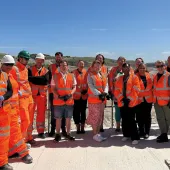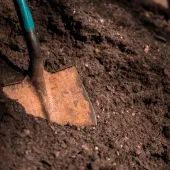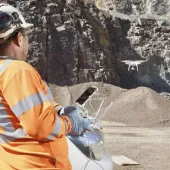Institute of Quarrying - The Early Days

First published in the October 2017 issue of Quarry Management
First part of a special supplement by Quarry Management to celebrate IQ's centenary
Simon McPherson, who was Secretary of the Institute from its inception in 1917 to his death in 1957, is generally considered to be the founder of the Institute. McPherson, or ‘Mac’ as he was generally known, was an energetic Scot from Aberdeen who was working in North Wales for the Enderby and Stony Stanton Granite Company during the First World War. An early issue of the Journal records that, in 1917, three local quarry managers, Owen Williams, Sam Richards and Josh Woodcock, who apparently did not know each other, had all broached the idea to him of starting an association of quarry managers at around the same time.
Accordingly, in October 1917, the four of them plus another local manager, William Jenkinson, held an informal meeting at the Prince of Wales Hotel in Caernarfon to discuss the idea of getting the new association off the ground.
At this meeting it was agreed that McPherson would take on the role of Hon. Secretary and, with the blessing of his employer, his first duty was to send out invitations to all the quarry managers in North Wales to a meeting that took place at the Sportsman’s Club in Porthmadog on 3 November.
William Jenkinson became the first Chairman and although the attendance of seven was disappointing, they decided to press on with the formation of The Quarry Managers’ Association and the first task was to formulate the aims and objectives of the new organization.
On 1 December a meeting was held with local quarry owners to allay any fears that their intention was to form a Trade Union for quarry managers, and, on 12 January 1918, the first Annual General Meeting took place in Caernarfon.
Unfortunately, due to the restricted train service in operation during the war, only three of the 19 members who had joined by that time managed to attend. Nevertheless, a management committee was formed and the objects of the Association were defined as ‘The discussion of technical and geological questions relating to quarrying and other matters relating to the control and welfare of quarries’. At this time Ordinary Membership was restricted to quarry managers, and quarry owners were made Honorary Members with the same privileges as Ordinary Members.
During the first year membership grew very slowly and, by the autumn of 1918, with a membership of only 50, Simon McPherson became convinced that regular publicity was needed to ensure the survival of the fledgling Association. Accordingly, he set about producing the first issue of The Quarry Managers’ Journal, which was duly published on 5 November 1918. It is interesting to note that, 99 years later, the Journal is still published on the 5th of the month!
As the Association had no funds to speak of, the production costs of £15, which was a considerable amount of money in those days, had to be covered by advertising from sympathetic suppliers to the industry.
The launch of the Journal proved to be the turning point in the fortunes of the Association and by the end of 1919 membership had risen to around 150. In that year Brigadier General Sir Henry Maybury, the influential Director of Works at the Ministry of Transport, accepted an invitation to become the first President and the Trade Members’ Section was also established to allow suppliers to the industry to join.
In 1920 the name was changed to the more dignified Institution of Quarry Managers of Great Britain and the annual subscription was suitably adjusted from 21 to 30 shillings. The following year the first conference took place at Olympia in London in conjunction with the Building Trades Exhibition. At the conference, eminent speakers, including three professors, presented papers on subjects including Crushing and Sifting, Industrial Accidents and Geological Characteristics of Roadstone. The programme also included a visit to the National Physical Laboratory to witness ‘a demonstration of apparatus for testing the properties of stone used in the construction of roads and the endurance of asphaltic carpets’.
In 1922 the first meeting of the Executive Council took place at the Raven Hotel, Shrewsbury, and at the AGM that year Simon McPherson tendered his resignation as Hon. Secretary as the burden of running the Journal as well as his Institution duties had become unsustainable. Fortunately, this was withdrawn after he was offered the support of a full-time secretary to help with administration and McPherson duly remained in post for another 35 years!
In any event, membership continued to increase and the annual conference grew in popularity as it moved to different venues around Great Britain. In the 1920s the conferences were rather relaxed affairs – activities were spread over the best part of a week and the programmes consisted of a mixture of technical and social events. In 1924 women were admitted for the first time.
As well as numerous dinners and visits to quarries, factories and places of general interest, there were also golf, tennis and bowls competitions. Cricket matches between the Members and the Trade Members’ Section were popular, as were the concerts of music and drama that were presented in the evenings.
The high point of the week was the annual banquet where members were rather given to indulging themselves with eating, drinking and speech-making, and it was quite common for an eight-course banquet to be followed by 10–12 speeches where toasts were proposed to all and sundry.
In 1926 at the Llandrindod Wells conference another innovation was introduced to the schedule in the form of an exhibition of plant and equipment held in a field adjacent to the hotel together with drilling demonstrations in a nearby quarry. This early forerunner of the Hillhead show was organized by Simon McPherson and a local quarry owner, Thomas Lant, and it proved to be a somewhat challenging experience because two days before the show was due to begin the heavens opened over Mid-Wales and the field became waterlogged, preventing vehicle movements on site.
As 42 wagons loaded with heavy machinery were held up in the local station yard something had to be done, and with characteristic resourcefulness Lant rescued the situation by building a road across to the field in record time so that the exhibition could go ahead. Another of Thomas Lant’s contributions to the Institute was the presentation of a splendid silver tankard to be awarded to the winner of the annual golf competition, which continues to this day.
The show itself was adjudged to be a great success and one innovation introduced was the presentation of working demonstrations of plant and equipment in a quarry environment. To this end, drilling demonstrations were mounted in a local quarry where Samuel Pegg and Son could be seen crushing stone for Messrs Stothert and Pitt to turn into tarmacadam.
The opportunity to see equipment at work clearly appealed to the industry, as did the chance to look round other people’s quarries. In this latter regard, the non-commercial remit provided by IQ was largely responsible for the acceptance by the industry of organized quarry visits for educational purposes. In 1917 it was rare for a quarry manager or owner to be invited to look around a neighbour’s quarry, but 10 years later it was commonplace.
Another early aim of the Institution was to promote the professional standing of its members through the certification of quarry managers. This issue aroused great passions at the time and scarcely an issue of the Journal went by without a letter to the editor from a quarry manager expounding the virtues of the scheme, with a response the following month from a quarry owner arguing against it.
During these early days the Journal quickly grew in size as it attracted an increasing volume of advertising, which was driven by the post-war mechanization of the industry. By 1923 concerns arose because advertisers were slow in paying their bills and a large amount of money was outstanding. As liability was unlimited, in the event of the Journal getting into financial difficulty the President and Secretary would have been held personally responsible for the debt.
Consequently, in May 1924 the Journal was formed into a limited company and shares were sold to raise the capital to set up a proper office for the two organizations, with Simon McPherson being employed in a full-time role as General Secretary of the Institution and editor of QMJ. Over the years the company published a number of titles in addition to the Journal, including Good Roads, Cement Lime and Gravel, Master Builder, Stone Trades Journal, Monumental Journal and the Directory of Quarries and Pits.
In January 1925, despite some protest from members in North Wales, the office was moved from its original base in Caernarfon to the more central location of Birmingham. In that year the Benevolent Fund was established with initial donations of £7 with which to start to help needy members and their dependents.
In 1927 the name of the organization was changed again to The Institute of Quarrying with the Trade Members’ Section being renamed the Associates’ Section. In this year the first lady member, Mrs Anne Greaves, was admitted into membership.
In 1930 the first move was made to try to develop a system of examinations for the quarrying industry and it was suggested that the Institute should assist with the establishment of a chair in quarrying at a university. This idea did not get off the ground at the time, but the Education Committee was established at this time as the means of fostering one of IQ’s core missions.
The Membership Committee was created six years later when it was noted that because of the General Secretary’s keenness to increase numbers, he was not always sufficiently rigorous in his scrutiny of applications!
In 1937, following a proposal from the West of England branch, a committee was formed under Brig. Gen. G.M. Jackson to consider the question of the Institute applying for a Royal Charter. The following year new bye-laws were drafted in preparation for the forthcoming petition; however, war broke out before it could be presented to the Privy Council.
By this time the IQ/QMJ office had moved from Birmingham to Salisbury Square, off Fleet Street in central London, which Simon McPherson thought was the right place for a publishing business to be based. Unfortunately, the Salisbury Square office suffered bomb damage in the early stages of the Second World War and, as was noted at the time, it was not easy to produce a Journal in an air-raid shelter. So, in September 1940, McPherson and his staff were evacuated to the safety of Cornwall where a temporary office in a disused railway carriage near Tintagel had been made available by a local quarry owner.
In June 1943 Simon McPherson and his staff returned to Salisbury Square, which, by this time, had been rebuilt. Also in this year, a sub-committee was established to start drafting the syllabus for the Institute’s first examinations. The war years were a quiet time for the Institute as all branch activities had ceased in order to free up time for members to contribute to the war effort. Council meetings continued, however, so the Institute’s aims could continue to be fostered. Also, the Quarry Managers’ Journal continued to be published throughout the conflict, although care had to be taken over the technical content.
- Subscribe to Quarry Management, the monthly journal for the mineral products industry, to read articles before they appear on Agg-Net.com








